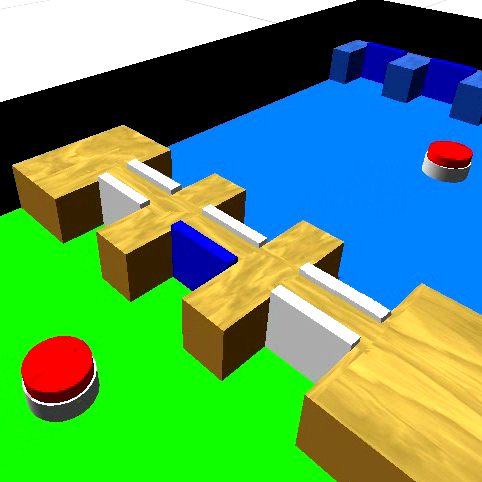by Giovanni Pini, Matteo Gagliolo, Arne Brutschy, Marco Dorigo, and Mauro Birattari
DATE: November 2012
|
Table of Contents |
Video - implementation of the cache using the TAM

|
The video explains how object transfer through the cache is implemented using the TAM. For more information about the TAM, please refer to the technical report 2010-015, and to the information that can be found here. In the video, e-pucks carrying objects are colored in red. Notice that the video was created with a previous version of ARGoS. |
TOP
Exp3, alternative abandon threshold computation
We tested two versions of the Exp3 algorithm, that differ in the method used for computing the abandon threshold. In the paper we chose to report the results of one of the two versions, here we report the results not reported in the paper. Note that the results are analogous to what reported in the paper and therefore we believe the method for computing the abandon threshold has little influence on Exp3.Performance for a constant interfacing time: available here
Performance for an interfacing time that switches from 0s to 160s, without communication: available here
Performance for an interfacing time that switches from 160s to 0s, without communication: available here
Performance for an interfacing time that switches from 160s to 0s, with communication: available here
TOP
Social algorithms, cache usage, complete results
This section contains plots reporting the percentage of usage of the cache in time for the complete set of 100 runs. We report here the results of the experiments in which the value of Π is initialized to 160 seconds and set to 0 when the experimental run reaches 1/4 of its duration. In each plot, the vertical blu line marks the instant in which the value of Π changes. Click on the following links to download a tar containing the results:Ad-hoc, complete results
UCB, complete results
εGreedy, complete results
TOP
Exp3, cache usage in time
The plot reports the percentage of usage of the cache in time for the exp3 algorithm (version used in the paper) in its non-social version. The top plot reports the case in which the interfacing time is initialized to 160 seconds and switched to 0 at a quarter of the experimental run. The bottom plot the dual case in which the interfacing time is initialized to 0 and switched to 160 seconds. In both cases we report both the percentage of selection and usage of the cache. The difference between the percentage of selection and of usage corresponds to the percentage of times the robots abandoned using the cache. The bottom plot shows that there is a high percentage of abandon following the variation of Π. As the robots have a low abandon threshold, the increased time needed to access the cache (due to the robots currently occupying it) increases the percentage of abandoning. With time the robots adapt the threshold to the new interfacing time value and abandon less often.The plot is available here
TOP
Social εAd-hoc and εUCB, cache usage, complete results
This section contains plots reporting the percentage of usage of the cache in time for the complete set of 100 runs, for the social versions of the Ad-hoc and UCB algorithms. We report here the results of the experiments in which the value of Π is initialized to 160 seconds and set to 0 when the experimental run reaches 1/4 of its duration. In each plot, the vertical blu line marks the instant in which the value of Π changes. Click on the following links to download a tar containing the results:εAd-hoc, complete results
εUCB, complete results
TOP